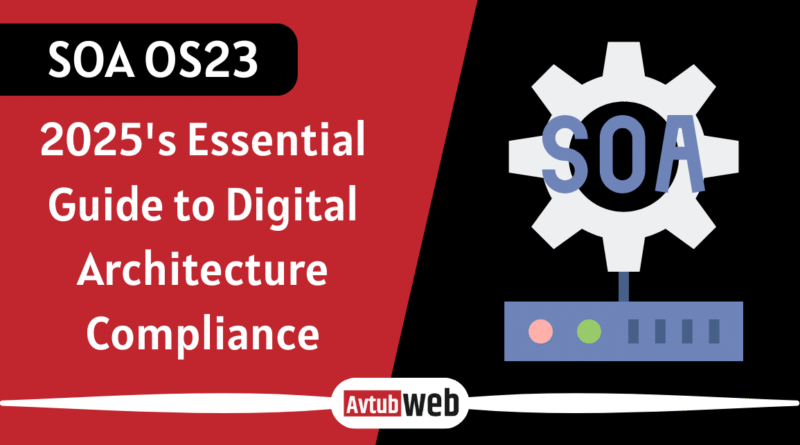Mastering SOA OS23: 2025’s Essential Guide to Digital Architecture Compliance
SOA OS23 is becoming one of the most important standards in digital architecture in 2025. As organizations adopt more flexible, scalable systems, the need for structured, compliant, and reusable service models has grown rapidly. SOA OS23, based on Service-Oriented Architecture (SOA), is designed to support this growth by focusing on modular design, standardized interfaces, and service compliance.
This guide explains everything you need to know about SOA OS23, from its principles to certification steps and real-world use cases. Whether you’re managing legacy system integration, working on public tenders, or planning a major shift in your digital strategy, understanding SOA OS23 will help align your services with modern performance, security, and governance standards.
What is SOA OS23? and Its 2025 Relevance
SOA OS23 is a new digital architecture standard that focuses on how services work together in modern software systems. It’s especially important in 2025 because businesses and governments now expect clear rules and consistent setups when building or using online services. OS23 helps by giving a solid structure for how these services talk to each other, making everything more secure, flexible, and easy to manage.
The Evolution of Service-Oriented Architecture: From Legacy Systems to OS23
Service-Oriented Architecture, or SOA, started out as a way to make older systems work better together. Over time, technology moved forward, and we needed faster, more efficient ways to handle complex systems. That’s where OS23 comes in—it takes the core ideas of SOA and updates them with tools like microservices, APIs, and cloud setups, making it a natural step forward from the old ways of doing things.
Breaking Down the OS23 Standard: Key Principles and Core Pillars
The OS23 standard is built around several clear principles that help developers design better systems. It focuses on keeping services simple, independent, and easy to replace or update. These key ideas—like making services stateless, loosely connected, and easy to reuse—form the backbone of OS23 and help teams build faster, safer, and more organized software.
OS23 is structured around foundational service principles:
| Pillar | Description |
| Service abstraction | Internal logic hidden behind a contract |
| Service autonomy | Services run independently |
| Service statelessness | State is externalized to improve resilience |
| Service granularity | Services handle fine-tuned responsibilities |
| Service composition | Services collaborate through orchestration and choreography |
| Loose coupling | Minimal dependency across services |
| Standardized interfaces | Unified REST or SOAP endpoints |
Why SOA OS23 Certification Is Important for Digital Architecture Compliance
Getting certified under SOA OS23 shows that a company’s software setup follows trusted, modern rules. This is a big deal for digital compliance in 2025. Certification helps companies prove they meet industry standards, making it easier to win contracts, pass audits, and stay secure while building systems that work well and last.
SOA OS23 in Public Procurement and Tenders: What Organizations Must Know
When governments or large companies look for tech partners, they now want proof that digital systems are secure, well-organized, and easy to inspect. OS23 fits right into these needs. If your company follows OS23, it can stand out in public tenders and procurement because your services are easier to manage, check, and trust. To dive deeper into how SOA OS23 is shaping the future of digital architecture, check out this detailed overview.

Who Needs SOA OS23 Certification? Profiles, Roles & Eligibility
OS23 certification isn’t just for big tech teams. It’s useful for anyone working with software architecture, cloud systems, or service delivery. Architects, engineers, compliance teams, and even security professionals can all benefit from understanding and applying OS23 rules in their daily work.
Certification Process Explained: Steps, Documentation & Key Milestones
Getting OS23 certified means going through a few clear steps. First, you review your system to see where it stands. Then, you gather the right documents, run system tests, pass an external review, and finally receive the certification. This process helps you improve your setup while proving your services are up to modern standards.
Tools and Technologies That Power OS23 Implementation in 2025
To apply OS23 in real-world systems, you’ll need the right tools. These include platforms that help services communicate, tools that track service performance, and systems that protect sensitive data. Technologies like API gateways, service mesh platforms, and container software like Docker are all commonly used to support OS23 setups.
Real-World Applications of SOA OS23: Use Cases Across Industries
Many industries already use OS23 in different ways. In healthcare, it helps protect patient data. In finance, it connects systems for trading and payments. In construction, it supports digital workflows. No matter the field, OS23 helps businesses build smarter, more reliable digital services that are easier to control and expand.
| Industry | Application |
| Healthcare | Patient data services with strict service privacy controls |
| Finance | Interoperable systems for trading platforms using service abstraction |
| Construction | Workflow orchestration in demolition & reconstruction projects |
| Telecom | Real-time billing using loosely coupled microservices |
Security, Governance, and Risk Management Under OS23 Standards
OS23 includes strong rules for keeping services secure and under control. It requires encryption, access rules, and logs for everything. This helps companies find problems fast and show that their systems are safe and well-managed. It’s a smarter way to keep digital risks low and meet today’s strict tech standards.
How to Migrate from Traditional SOA to OS23-Driven Frameworks
Moving from older SOA systems to OS23 doesn’t mean starting over. It means updating your services step by step—switching old interfaces for newer ones, breaking big services into smaller ones, and adding tools for monitoring and automation. This kind of upgrade helps companies modernize without losing what already works.

Benefits of Adhering to “SOA OS23” (Hypothetical)
By following OS23, companies often see real gains. Systems become easier to scale, services launch faster, and teams spend less time fixing problems. With stronger organization and better tools, businesses can improve performance and lower costs while staying ready for audits, growth, or tech changes.
Common Challenges in Achieving and Sustaining OS23 Certification
Even though OS23 has big benefits, it can also be challenging. Getting started takes time and money. Teams may need to learn new tools, write more documentation, and improve service designs. It’s not always easy to keep everything up to date, but the long-term rewards make the effort worth it.
Digital Transformation in Architecture: OS23’s Role in Demolition & Construction Workflows
In industries like construction and architecture, OS23 helps connect physical work with digital planning. It supports smart workflows, connects 3D models with backend tools, and makes it easier to manage complex projects. By using OS23, construction teams can move faster while staying accurate and compliant.
The Future of SOA OS23: Trends, Innovations & Regulatory Forecasts for 2025–2030
Looking ahead, OS23 is likely to become a standard requirement in many industries. New trends like AI-driven monitoring, stricter regulations, and smarter service tools are all pushing companies to adopt more structured, compliant systems. Over the next few years, OS23 could become a key part of how digital services are built, run, and improved.
Conclusion
SOA OS23 is setting a new standard for how digital services are built, organized, and maintained in 2025. It brings structure to complex systems through principles like modular design, loose coupling, and standardized interfaces. From public procurement to private enterprise, it helps teams improve service reliability, scalability, and compliance. Whether you’re managing microservices architecture, working with legacy system integration, or aiming for better service governance, OS23 gives a practical framework to get there. As digital transformation accelerates, staying aligned with OS23 can help organizations stay prepared, secure, and future-ready.



